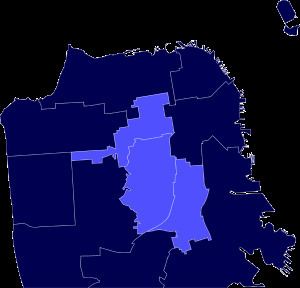November 8, 2011 (2011-11-08) 2015 → 30.75% 19.26% 59.64% 40.36% | 59,775 37,445 84,457 57,160 Start date November 8, 2011 | |
 | ||
Winner Ed Lee | ||
The 2011 San Francisco mayoral election was held on Tuesday, November 8, 2011, to elect the mayor of San Francisco. The incumbent, Ed Lee, succeeded in his bid to become the first elected Asian-American mayor of a major American city.
Contents
Background
Gavin Newsom, first elected in 2003 and reelected in 2007, was elected Lieutenant Governor of California in 2010 and sworn in on January 10, 2011. Ed Lee was appointed by the San Francisco Board of Supervisors to finish the balance of Newsom's mayoral term and was sworn in on January 11, 2011. Lee initially pledged not to seek election, although an active movement arose to draft him into the race. By the end of July observers were expecting that Lee would agree to run. On August 8, 2011, Lee announced he was running for Mayor of San Francisco.
The election was run using instant runoff voting. It was the first decided by the preference voting adopted by a referendum in 2002.
Candidates
There were sixteen candidates running:
Debates
Polling
Results Summary
The following table shows a summary of the instant runoff for the election. The table shows the round in which the candidate was defeated or elected the winner, the votes for the candidate in that round, and what share those votes were of all votes counting for any candidate in that round. There is also a bar graph showing those votes for each candidate and categorized as either first-round votes or votes that were transferred from another candidate.
Municipal elections in California are officially non-partisan, though most candidates in San Francisco do receive funding and support from various political parties.
Vote counts by round
The following table shows how votes were counted in a series of rounds of instant runoffs. Each voter could mark which candidates were the voter's first, second, and third choice. Each voter had one vote, but could mark three choices for how that vote can be counted. In each round, the vote is counted for the most preferred candidate that has not yet been eliminated. Then one or more candidates with the fewest votes are eliminated. Votes that counted for an eliminated candidate are transferred to the voter's next most preferred candidate that has not yet been eliminated.
Continuing votes are votes that counted for a candidate in that round. Exhausted ballots represent votes that could not be transferred because a less preferred candidate was not marked on the ballot. Voters were allowed to mark only three choices because of voting system limitations. Over votes are votes that could not be counted for a candidate because more than one candidate was marked for a choice that was ready to be counted. Under votes are ballots were left blank or that only marked a choice for a write-in candidate that had not qualified as a write-in candidate.
